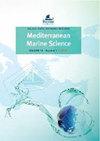杰尔巴岛(突尼斯,东地中海)沿海地区夏季微小浮游生物和浮游动物群落与环境参数的空间变化
IF 2.3
3区 环境科学与生态学
Q1 MARINE & FRESHWATER BIOLOGY
引用次数: 0
摘要
在本研究中,我们调查了污染和人为化对杰尔巴岛海岸带植物浮游动物群落夏季分布的影响,以及与环境因素的关系。根据化学因素,杰尔巴海岸可分为两部分:西部地区(WA),其特征是氮形式的营养物质含量高,氮磷比较高;东部地区(EA),其无机氮含量较低,氮磷比比雷德菲尔德比低(16)。这两个地区的浮游生物群落也存在很大差异。硅藻科是西澳大利亚最重要的微浮游生物类群,而蓝细菌在东澳大利亚的比例更高。EA中高蓝细菌丰度可能与高DIP浓度有关。在西澳大利亚州,毛球藻科(Bacillarophyceae Chaetoceros)、Coscinodica、Gramatophora、Navicula和Pinnularia的丰度较高,这与它们对不利条件的良好适应性有关。桡足类是西澳州最丰富的浮游动物(占浮游动物总丰度的54–100%),而其他浮游动物在EA中始终占主导地位(60–90%)。小型耐污染类桡足类Paracalanus parvus在西澳占主导地位,表明其对高度富营养化位点的亲和力。尽管有人类的压力和工业活动,杰尔巴沿海水域的微型浮游生物和浮游动物种类繁多。本文章由计算机程序翻译,如有差异,请以英文原文为准。
Spatial variation of summer microphytoplankton and zooplankton communities related to environmental parameters in the coastal area of Djerba Island (Tunisia, Eastern Mediterranean)
In the present study, we investigated the effects of pollution and anthropization on the summer distribution of phyto-zooplanktoncommunities in relation to environmental factors in the coastal zone of DjerbaIsland. On the basis of chemical factors, theDjerba coasts can be divided into two parts: the Western Area (WA), characterized by high values of nitrogen forms of nutrients,with higher N/P ratio, and the Eastern Area (EA), poorer in inorganic nitrogen with an N/P ratio lower than the Redfield ratio (16).Strong differences in terms of plankton communities were also observed between these two areas. Bacillariophyceae was the most important microphytoplankton group in the WA whereas the proportion of Cyanobacteria was higher in the EA. High Cyanobacteria abundance in the EA may be linked to high DIP concentration. In the WA, the Bacillariophyceae Chaetoceros, Coscinodiscus, Grammatophora, Navicula and Pinnularia reached high abundance in relation with their good adaptability to adverse conditions. Copepods were the most abundant zooplankton present in the WA (54–100% of total zooplankton abundance), whereas other zooplankton were always dominant (60–90%) in the EA. The small pollution-tolerant Calanoid copepod Paracalanus parvus was dominant in the WA, illustrating its affinity for highly eutrophic sites. Despite human pressure and industrial activities, the coastal waters of Djerba showed a wide diversity of microphytoplankton and zooplankton.
求助全文
通过发布文献求助,成功后即可免费获取论文全文。
去求助
来源期刊

Mediterranean Marine Science
MARINE & FRESHWATER BIOLOGY-
CiteScore
5.20
自引率
17.90%
发文量
34
审稿时长
>12 weeks
期刊介绍:
The journal Mediterranean Marine Science (MMS), published by the Hellenic Centre for Marine Research (HCMR), issues three volumes annually. The journal welcomes original research articles, short communications, New Mediterranean Biodiversity records, extended reviews, comments, and Theme sections in all fields of Oceanography, Marine Biology, Marine Conservation, Fisheries and Aquaculture in the Mediterranean area and the adjacent regions. All content is peer reviewed.
 求助内容:
求助内容: 应助结果提醒方式:
应助结果提醒方式:


